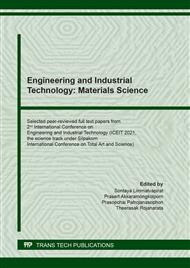[1]
S. Bräse, C. Gil, K. Knepper, V. Zimmermann, Organic azides: An exploding diversity of a unique class of compounds, Angew. Chem., Int. Ed. Engl. 44 (2005) 5188-5240.
DOI: 10.1002/anie.200400657
Google Scholar
[2]
S.G. Alvarez, M.T. Alvarez, A Practical procedure for the synthesis of alkyl azides at ambient temperature in dimethyl sulfoxide in high purity and yield, Synthesis. (1997) 413-414.
DOI: 10.1055/s-1997-1206
Google Scholar
[3]
E. Lieber, T.S. Chao, C.N.R. Rao, Improved method for the synthesis of alkyl azides, J. Org. Chem. 22 (1956) 238-240.
Google Scholar
[4]
S. Bräse, K. Banert, Organic azides syntheses and applications, A John Wiley & Sons, West Sussex, (2010).
Google Scholar
[5]
N. Kuhnert, Microwave-assisted reactions in organic synthesis–Are there any nonthermal microwave effects?, Angew. Chem. Int. Ed. 41 (2002) 1863-1866.
DOI: 10.1002/1521-3773(20020603)41:11<1863::aid-anie1863>3.0.co;2-l
Google Scholar
[6]
D. Dheer, V. Singh, R. Shankar, Medicinal attributes of 1,2,3-triazoles: Current developments, Bioorg. Chem. 71 (2017) 30-54.
DOI: 10.1016/j.bioorg.2017.01.010
Google Scholar
[7]
R. Huisgen. 1,3-Dipolar cycloadditions. Past and future, Angew. Chem. Int. Ed. 2 (1963) 565-598.
DOI: 10.1002/anie.196305651
Google Scholar
[8]
V.V. Rostovtsev, L.G. Green, V.V. Fokin, K.B. Sharpless. A stepwise Huisgen cycloaddition process: Copper (I)-catalyzed regioselective Ligation, of azides and terminal alkynes, Angew. Chem. Int. Ed. 41 (2002) 2596-2599.
DOI: 10.1002/1521-3773(20020715)41:14<2596::aid-anie2596>3.0.co;2-4
Google Scholar
[9]
S.G. Hansen, H.H. Jensen, Microwave irradiation as an effective means of synthesizing unsubstituted N-linked 1,2,3-triazoles from vinyl acetate and azides, Synlett 20 (2009) 3275-3278.
DOI: 10.1055/s-0029-1218366
Google Scholar
[10]
P. Kanjanapruk, S. Niratisai, K. Pochanakom. 2014, May 1-3. Synthesis of bromobenzhydrol derivatives as novel antituberculosis agents. The 3rd Current Drug Development International Conference, Krabi, Thailand.
Google Scholar
[11]
S. Xu, X. Zhuang, X. Pan, Z. Zhang, L. Duan, Y. Liu, et al., 1‑Phenyl-4-benzoyl‑1H‑1,2,3-triazoles as orally bioavailable transcriptional function suppressors of estrogen-related receptor α, J. Med. Chem. 56 (2013) 4631-4640.
DOI: 10.1021/jm4003928
Google Scholar
[12]
Information on http://www.sciencemadness.org.
Google Scholar
[13]
T.B. Phan, H. Mayr, Nucleophilic reactivity of the azide ion in various solvents, J. Phys. Org. Chem. 19 (2006) 706-713.
DOI: 10.1002/poc.1063
Google Scholar
[14]
E. Lieber, C.N.R. Rao, A.E. Thomas, E. Oftedahl, R. Minnis , C.V.N. Nambury, Infrared spectra of acid azides, carbamyl azides and other azido derivatives. Anomalous splittings of the N3, stretching bands, Spectrochim. Acta. 19 (1963) 1135-1144.
DOI: 10.1016/0371-1951(63)80033-8
Google Scholar
[15]
X. Creary, A. Anderson, C. Brophy, F. Crowell, Z. Funk, Method for assigning structure of 1,2,3-triazoles, J. Org. Chem. 77 (2012) 8756-8761.
DOI: 10.1021/jo301265t
Google Scholar
[16]
A.G. Brenton, A.R. Godfrey, Accurate mass measurement: terminology and treatment of data, J. Am. Soc. Mass Spectrom. 21 (2010) 1821-1835.
DOI: 10.1016/j.jasms.2010.06.006
Google Scholar


